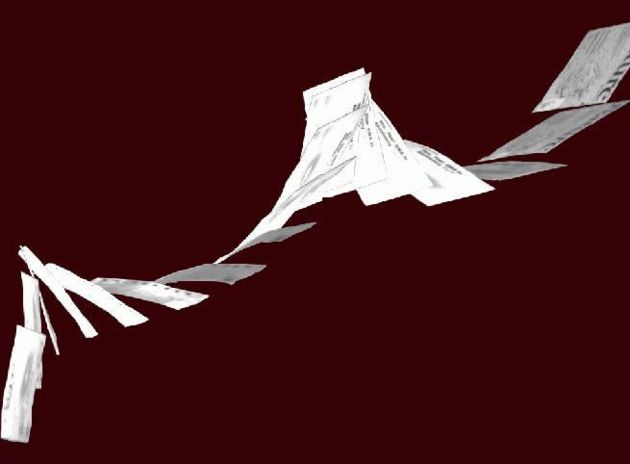New Study: How Leaves Fall

The downward dance of a doomed leaf on crisp fall day might seem as unpredictable as any event in Nature. But a new study helps explain how your neighbor's prized oak can generate your raking nightmare even in the absence of wind.
The formula for freefall of thin, light objects was deciphered by studying how a page from a scientific journal cascades to the floor, and solving the mathematical equation of air motion during the fall.
Scientists photographed the sheet of falling paper with a high-speed camera and found that it actually rises at certain points on the way down. The graceful descent is part flight, part fall, and it is more efficient at delaying the inevitable than a parachute.
The research was led by Z. Jane Wang of Cornell University.
Fly, stall, flutter
While the fall of a leaf is more difficult to model, certain types of paper are surprisingly predictable, Wang said, adding that the same forces seem to be at work in each case. A dropped business card is among the easiest to model, and the final state of its fall does not even depend on how it is released.
"For some cases we can predict very well which direction it will fall and how far it will fall," Wang told LiveScience.
Sign up for the Live Science daily newsletter now
Get the world’s most fascinating discoveries delivered straight to your inbox.
The halting downward flutter of a thin thing is controlled by air that swirls around its edges, Wang explained. It's similar to the swirls created by an oar in the water, she sad. As a piece of paper tumbles, air curls around its edges and creates pressure differences that create lift.
In essence, the page alternates between flying and stalling out, somewhat like what can happen to an airplane moving too slowly. But the lift at work on paper, unlike with an airfoil, depends on the page's tumbling action and its rotational speed.
"The surprising thing is that the force acting on a piece of paper is very different than on an airplane wing, even during the gliding portion of the trajectory," Wang said.
150-year mystery
Scientists have been intrigued by the problem at least since 1853, when Scottish physicist James Maxwell considered the motion of playing cards. Why hasn't it been solved until now?
"It's a hard problem," Wang said, "because the exact trajectory depends on the complex air motions." It took two weeks of computer time to successfully model the movements and forces.
The phenomenon is more than twice as effective at slowing an object's descent compared to a parachute, Wang and her colleague, graduate student Umberto Pesavento, write in a recent issue of the journal Physical Review Letters. The researchers point out that some trees and other plants take advantage of the effect by producing flat seed pods to disperse their potential offspring.
While Wang cannot tell you where all this year's leaves will end up, she has solved one annual mystery.
"What is predictable is that as the autumn leaves tumble down, they drift in particular directions, depending on the way they turn, Wang said. "This may explain why you are getting the leaves from your neighbor."
Robert is an independent health and science journalist and writer based in Phoenix, Arizona. He is a former editor-in-chief of Live Science with over 20 years of experience as a reporter and editor. He has worked on websites such as Space.com and Tom's Guide, and is a contributor on Medium, covering how we age and how to optimize the mind and body through time. He has a journalism degree from Humboldt State University in California.










